Metrohm 915KF User Manual
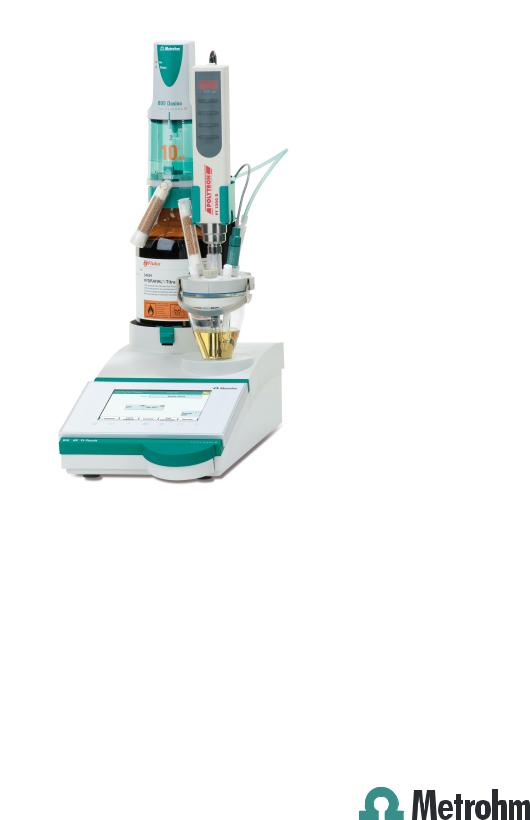
915 KF Ti-Touch
Manual
8.915.8005EN / 2014-03-10

Metrohm AG CH-9100 Herisau Switzerland
Phone +41 71 353 85 85 Fax +41 71 353 89 01 info@metrohm.com www.metrohm.com
915 KF Ti-Touch
Program version 5.915.0030
Manual
8.915.8005EN / 2014-03-10 |
ebe |
Teachware Metrohm AG CH-9100 Herisau
teachware@metrohm.com
This documentation is protected by copyright. All rights reserved.
Although all the information given in this documentation has been checked with great care, errors cannot be entirely excluded. Should you notice any mistakes please send us your comments using the address given above.
Documentation in additional languages can be found on
http://documents.metrohm.com.
Melody for the BEEP command: excerpt from "En Altfrentsche", with kind permission of the Laseyer Quartett, Appenzell.
|
Table of contents |
Table of contents
1 Introduction |
1 |
|
1.1 |
Instrument description ......................................................... |
1 |
1.1.1 |
Titration and measuring modes ................................................ |
1 |
1.1.2 |
Connectors .............................................................................. |
2 |
1.1.3 |
Intended use ........................................................................... |
2 |
1.2 |
About the documentation ................................................... |
3 |
1.2.1 |
Symbols and conventions ........................................................ |
3 |
2 Safety instructions |
5 |
|
2.1 |
General notes on safety ....................................................... |
5 |
2.2 |
Electrical safety ..................................................................... |
5 |
2.3 |
Tubing and capillary connections ....................................... |
6 |
2.4 |
Flammable solvents and chemicals ..................................... |
6 |
2.5 |
Recycling and disposal ......................................................... |
7 |
3 Overview of the instrument |
8 |
||
3.1 |
Front of the instrument ........................................................ |
8 |
|
3.2 |
Rear of the instrument ......................................................... |
9 |
|
4 Installation |
|
10 |
|
4.1 |
Setting up the instrument .................................................. |
10 |
|
4.1.1 |
Packaging .............................................................................. |
10 |
|
4.1.2 |
Checks .................................................................................. |
10 |
|
4.1.3 |
Location ................................................................................ |
10 |
|
4.2 |
Connecting the power supply unit .................................... |
10 |
|
4.3 |
|
Connecting MSB devices .................................................... |
12 |
4.3.1 |
Connecting dosing devices .................................................... |
13 |
|
4.3.2 |
Connecting an additional stirrer or titration stand .................. |
14 |
|
4.3.3 |
Connecting a Remote Box ..................................................... |
14 |
|
4.4 |
|
Connecting USB devices ..................................................... |
15 |
4.4.1 |
General ................................................................................. |
15 |
|
4.4.2 |
Connecting a USB hub ........................................................... |
15 |
|
4.4.3 |
Connecting a printer .............................................................. |
15 |
|
4.4.4 |
Connecting a balance ............................................................ |
16 |
|
4.4.5 |
Connecting a PC keyboard ..................................................... |
17 |
|
4.4.6 |
Connecting a barcode reader ................................................. |
17 |
|
4.4.7 |
Connecting a Sample Processor ............................................. |
18 |
|
4.5 |
Setting up the titration vessel ........................................... |
19 |
|
915 KF Ti-Touch |
III |
Table of contents |
|
|
|
|
4.6 |
Connecting sensors ............................................................ |
19 |
|
4.6.1 |
General ................................................................................. |
19 |
|
4.6.2 |
Connecting a polarizable electrode ........................................ |
19 |
|
4.6.3 |
Connecting a temperature sensor .......................................... |
20 |
|
4.7 |
Connecting the Ti-Touch to a network ............................ |
21 |
5 |
Titrations |
|
23 |
|
5.1 |
Water determination according to Karl Fischer (KFT) ..... |
23 |
6 |
Operation |
|
24 |
|
6.1 |
Switching the instrument on and off ............................... |
24 |
|
6.2 |
Fundamentals of operation ............................................... |
26 |
|
6.2.1 |
Touch-sensitive screen ........................................................... |
26 |
|
6.2.2 |
Display elements and controls ................................................ |
26 |
|
6.2.3 |
Status display ........................................................................ |
27 |
|
6.2.4 |
Entering text and numbers ..................................................... |
28 |
7 |
System settings |
31 |
|
|
7.1 |
General system settings ..................................................... |
31 |
|
7.1.1 |
Selecting the dialog language ................................................ |
31 |
|
7.1.2 |
Setting the date, time and local time ..................................... |
32 |
|
7.2 |
System-specific dialog options .......................................... |
33 |
|
7.3 |
User administration ............................................................ |
37 |
|
7.3.1 |
Editing the user configuration ................................................ |
38 |
|
7.3.2 |
Creating an identification profile ............................................ |
40 |
|
7.3.3 |
Defining login options ........................................................... |
41 |
|
7.3.4 |
Password options .................................................................. |
42 |
|
7.4 |
Measured value display ..................................................... |
45 |
|
7.5 |
Acoustic signals .................................................................. |
45 |
8 |
Titrants |
|
46 |
|
8.1 |
Adding a new titrant .......................................................... |
47 |
|
8.2 |
Editing titrant data ............................................................. |
48 |
|
8.3 |
Monitoring the working life .............................................. |
50 |
|
8.4 |
Dosing unit .......................................................................... |
51 |
|
8.4.1 |
Parameters for preparing (PREP) and emptying (EMPTY) ......... |
52 |
|
8.4.2 |
Tubing parameters ................................................................. |
53 |
|
8.4.3 |
Shift direction of the valve disk .............................................. |
56 |
|
8.5 |
Exchange unit ..................................................................... |
57 |
|
8.5.1 |
Parameters for the preparation (PREP) .................................... |
58 |
|
8.5.2 |
Tubing parameters ................................................................. |
59 |
|
8.6 |
GLP test for exchange unit and dosing unit .................... |
61 |
IV |
915 KF Ti-Touch |
|
|
Table of contents |
8.7 |
Titer determination options and data .............................. |
63 |
8.7.1 |
Titer validity ........................................................................... |
63 |
8.7.2 |
Properties of the previous titer determinations ....................... |
64 |
9 Reagents |
|
66 |
9.1 |
Editing reagent data .......................................................... |
66 |
9.2 |
Reagent monitoring ........................................................... |
67 |
10 Sensors |
|
70 |
10.1 |
Adding a new sensor ......................................................... |
71 |
10.2 |
Editing the sensor data ...................................................... |
71 |
10.3 |
Monitoring the working life .............................................. |
72 |
11 Device manager |
74 |
|
11.1 |
Adding a new device .......................................................... |
75 |
11.2 |
Configuring the instrument ............................................... |
75 |
11.3 |
Ti-Touch ............................................................................... |
76 |
11.3.1 |
E-mail .................................................................................... |
77 |
11.3.2 |
PC/LIMS report ...................................................................... |
78 |
11.3.3 |
Shared memory ..................................................................... |
79 |
11.3.4 |
TCP/IP settings ....................................................................... |
81 |
11.4 |
Metrohm control devices ................................................... |
82 |
11.4.1 |
Properties – Measuring input ................................................. |
83 |
11.4.2 |
Properties – MSB connector ................................................... |
84 |
11.4.3 |
Properties – Peripheral devices ............................................... |
85 |
11.5 |
USB Sample Processor ....................................................... |
85 |
11.5.1 |
Properties – Sample Processor ............................................... |
86 |
11.5.2 |
Properties – Tower ................................................................ |
87 |
11.5.3 |
Properties – Swing Head ........................................................ |
89 |
11.6 |
Sample racks ....................................................................... |
93 |
11.6.1 |
Editing rack data .................................................................... |
95 |
11.6.2 |
Rack adjustment .................................................................. |
100 |
11.7 |
Printer ................................................................................ |
101 |
11.7.1 |
PDF settings ......................................................................... |
103 |
11.7.2 |
Network printer ................................................................... |
104 |
11.7.3 |
More options ....................................................................... |
105 |
11.8 |
Balance .............................................................................. |
106 |
11.9 |
USB/RS-232 adapter ......................................................... |
107 |
11.10 |
PC keyboard ...................................................................... |
109 |
11.11 |
Barcode reader ................................................................. |
110 |
915 KF Ti-Touch |
V |
Table of contents |
|
|
12 File manager |
113 |
|
12.1 |
Managing files .................................................................. |
113 |
12.1.1 |
Copying a file ...................................................................... |
115 |
12.1.2 |
Renaming a file ................................................................... |
115 |
12.1.3 |
File properties ...................................................................... |
116 |
12.2 |
External storage medium ................................................ |
117 |
12.3 |
Creating backups / Restoring data ................................. |
119 |
12.3.1 |
Restoring data ..................................................................... |
119 |
13 GLP manager |
121 |
|
13.1 |
Automatic system test ..................................................... |
122 |
13.2 |
Test tools .......................................................................... |
122 |
13.3 |
GLP tests for measurement and titration ...................... |
123 |
13.3.1 |
Parameter description .......................................................... |
124 |
13.4 |
System validation ............................................................. |
127 |
13.4.1 |
Parameter description .......................................................... |
128 |
13.5 |
System monitoring ........................................................... |
131 |
13.5.1 |
Service interval .................................................................... |
131 |
13.5.2 |
Backup interval .................................................................... |
132 |
14 Common variables |
133 |
|
14.1 |
Editing common variables ............................................... |
134 |
14.2 |
Properties of common variables ..................................... |
135 |
14.3 |
Monitoring validity ........................................................... |
136 |
14.4 |
Assigning a result automatically to a common varia- |
|
|
ble ...................................................................................... |
137 |
15 Templates |
|
139 |
15.1 |
Sample data ...................................................................... |
139 |
15.1.1 |
Sample identification list ...................................................... |
140 |
15.1.2 |
Sample assignment table ..................................................... |
141 |
15.2 |
Custom result templates .................................................. |
143 |
15.2.1 |
Editing result templates ....................................................... |
144 |
15.3 |
Input lines ......................................................................... |
147 |
15.3.1 Editing the input signal ........................................................ |
148 |
|
15.4 |
Output lines ...................................................................... |
149 |
15.4.1 Editing the output signal ...................................................... |
151 |
|
15.5 |
Report header ................................................................... |
152 |
16 Methods |
|
154 |
16.1 |
Creating a new method ................................................... |
154 |
VI |
915 KF Ti-Touch |
|
|
Table of contents |
|
|
16.2 |
Saving a method ............................................................... |
155 |
|
16.3 |
Loading a method ............................................................ |
156 |
|
16.4 |
Editing a method .............................................................. |
157 |
|
16.4.1 |
Inserting a command ........................................................... |
158 |
|
16.5 |
Method options ................................................................ |
159 |
|
16.5.1 |
Start options ........................................................................ |
160 |
|
16.5.2 |
Stop options ........................................................................ |
162 |
|
16.5.3 |
Sample data ........................................................................ |
163 |
|
16.5.4 |
Method properties ............................................................... |
167 |
|
16.5.5 |
Note .................................................................................... |
167 |
|
16.5.6 Saving a determination automatically ................................... |
167 |
|
17 |
Control |
|
170 |
18 |
Favorites |
|
174 |
|
18.1 |
Creating favorites ............................................................. |
175 |
|
18.1.1 |
Editing favorites ................................................................... |
175 |
19 |
Sample data |
178 |
|
|
19.1 |
Entering sample data in the main dialog ....................... |
178 |
|
19.2 |
Requesting sample data at the start of the determina- |
|
|
|
tion .................................................................................... |
179 |
20 |
Sample table |
181 |
|
|
20.1 |
General .............................................................................. |
181 |
|
20.2 |
Edit the sample data ........................................................ |
184 |
|
20.3 |
Properties .......................................................................... |
186 |
21 |
Determination run |
189 |
|
|
21.1 |
Carrying out a single determination ............................... |
189 |
|
21.2 |
Performing a sample series ............................................. |
190 |
|
21.3 |
Canceling determinations manually ............................... |
191 |
22 |
Live modifications |
192 |
|
22.1Editing the sample data of the running determina-
tion .................................................................................... |
192 |
22.2Editing the sample table while a determination is run-
|
ning .................................................................................... |
193 |
22.3 |
Live display ....................................................................... |
194 |
22.4 |
Live parameters ................................................................ |
196 |
915 KF Ti-Touch |
VII |
Table of contents |
|
|
23 Results and more determination data |
198 |
|
23.1 |
More determination data ................................................ |
199 |
23.1.1 |
Details ................................................................................. |
200 |
23.2 |
Messages ........................................................................... |
202 |
23.3 |
Local common variables .................................................. |
202 |
23.4 |
Determination properties ................................................ |
203 |
23.5 |
Loading a determination ................................................. |
204 |
23.5.1 |
Determination list ................................................................ |
205 |
23.6 |
Saving a determination .................................................... |
210 |
23.7 |
Curves ................................................................................ |
210 |
23.8 |
Recalculation and reevaluation ....................................... |
212 |
24 Statistics |
|
214 |
24.1 |
Displaying details for a result .......................................... |
216 |
24.2 |
Deleting statistical data ................................................... |
217 |
24.3 |
Adding a determination to a determination series ....... |
217 |
25 Result table |
|
219 |
25.1 |
Properties .......................................................................... |
220 |
25.2 |
Saving the result table ..................................................... |
224 |
25.3 |
Loading the result table ................................................... |
224 |
26 Printing |
|
225 |
26.1 |
General report options ..................................................... |
227 |
26.2 |
Settings of the individual reports ................................... |
228 |
26.3 |
List of all printable reports .............................................. |
229 |
27 Manual control |
233 |
|
27.1 |
Opening and closing the manual control ....................... |
234 |
27.2 |
Measuring ......................................................................... |
235 |
27.2.1 |
Parameter description .......................................................... |
236 |
27.3 |
Dosing ............................................................................... |
237 |
27.3.1 |
Continuous dosing .............................................................. |
239 |
27.3.2 |
Dosing fixed volumes ........................................................... |
241 |
27.3.3 |
Preparing ............................................................................. |
244 |
27.3.4 |
Emptying ............................................................................. |
245 |
27.3.5 |
Filling .................................................................................. |
245 |
27.3.6 |
Replacing reagent ................................................................ |
246 |
27.4 |
Stirring ............................................................................... |
246 |
VIII |
915 KF Ti-Touch |
|
|
|
Table of contents |
|
27.5 |
Remote .............................................................................. |
|
248 |
|
27.6 |
USB Sample Processor ..................................................... |
|
249 |
|
27.6.1 |
|
Moving the lift ..................................................................... |
|
251 |
27.6.2 |
|
Moving to a rack position .................................................... |
|
253 |
27.6.3 |
|
External positions ................................................................ |
|
254 |
28 Parameters |
|
|
|
259 |
28.1 Volumetric Karl Fischer titrations (KFT) ......................... |
|
259 |
||
28.1.1 |
|
Start conditions ................................................................... |
|
259 |
28.1.2 |
|
Control parameters .............................................................. |
|
261 |
28.1.3 |
|
Titration parameters ............................................................ |
|
264 |
28.1.4 |
|
Stop conditions ................................................................... |
|
265 |
28.1.5 |
|
Conditioning ....................................................................... |
|
266 |
28.1.6 |
|
Cell ...................................................................................... |
|
268 |
28.1.7 |
|
Control device ..................................................................... |
|
268 |
28.1.8 |
|
Sensor ................................................................................. |
|
269 |
28.1.9 |
|
Dosing device ...................................................................... |
|
270 |
28.1.10 |
Stirrer .................................................................................. |
|
271 |
|
28.2 |
Measurements (MEAS) ..................................................... |
|
272 |
|
28.2.1 |
|
Measuring parameters ......................................................... |
|
272 |
28.2.2 |
|
Control device ..................................................................... |
|
274 |
28.2.3 |
|
Sensor ................................................................................. |
|
274 |
28.2.4 |
|
Stirrer .................................................................................. |
|
276 |
28.3 |
Evaluations (EVAL) ........................................................... |
|
277 |
|
28.3.1 |
|
Fixed endpoint evaluation (EVAL FIX-EP) .............................. |
|
277 |
28.3.2 |
|
Minimum and maximum evaluation (EVAL MIN/MAX) |
.......... 279 |
|
28.3.3 |
|
Break point evaluation (EVAL BREAK) ................................... |
|
280 |
28.3.4 |
|
Rate evaluation (EVAL RATE) ................................................ |
|
282 |
28.4 |
Calculations ....................................................................... |
|
283 |
|
28.4.1 |
|
Calculations (CALC) ............................................................. |
|
283 |
28.4.2 |
|
Calculations (CALC LIVE) ...................................................... |
|
291 |
28.4.3 |
|
Formula editor ..................................................................... |
|
293 |
28.5 |
Reports (REPORT) ............................................................. |
|
299 |
|
28.5.1 |
|
General report options ......................................................... |
|
299 |
28.5.2 |
|
Settings of the individual reports .......................................... |
|
300 |
28.5.3 |
|
List of reports ...................................................................... |
|
301 |
28.6 Dosing and Liquid Handling ............................................ |
|
304 |
||
28.6.1 |
|
Preparing an exchange or dosing unit (PREP) ........................ |
|
304 |
28.6.2 |
|
Emptying a dosing unit (EMPTY) .......................................... |
|
305 |
28.6.3 |
|
Dosing a specified volume (ADD) ......................................... |
|
306 |
28.6.4 |
|
Liquid Handling (LQH) .......................................................... |
|
311 |
28.7 |
Communication ................................................................ |
|
314 |
|
28.7.1 |
|
Scanning remote lines (SCAN) .............................................. |
|
314 |
28.7.2 |
|
Setting remote lines (CTRL) .................................................. |
|
316 |
28.7.3 |
|
Scanning the RS-232 interface (SCAN RS) ............................. |
|
317 |
28.7.4 |
|
Defining RS-232 commands (CONTROL RS) .......................... |
|
318 |
915 KF Ti-Touch |
IX |
Table of contents |
|
|
28.8 |
Automation ....................................................................... |
319 |
28.8.1 Rotating sample rack (MOVE) .............................................. |
319 |
|
28.8.2 Moving the lift (LIFT) ............................................................ |
321 |
|
28.8.3 |
Controlling pumps (PUMP) ................................................... |
322 |
28.8.4 Resetting the rack (RACK) .................................................... |
323 |
|
28.8.5 Defining the sample variable (SAMPLE) ................................ |
323 |
|
28.8.6 Creating a subsequence (SUBSEQ) ....................................... |
324 |
|
28.9 |
Miscellaneous commands ................................................ |
327 |
28.9.1 Controlling a stirrer (STIR) .................................................... |
327 |
|
28.9.2 Pausing the method run (WAIT) ........................................... |
328 |
|
28.9.3 |
Scan data (REQUEST) ........................................................... |
329 |
28.9.4 Defining an acoustic signal (BEEP) ........................................ |
330 |
|
28.9.5 Canceling the method run (END) ......................................... |
330 |
|
29 Operation and maintenance |
331 |
|
29.1 |
System initialization ......................................................... |
331 |
29.2 |
Quality management and qualification with Metrohm |
332 |
30 Troubleshooting |
333 |
|
30.1 |
Editing methods ............................................................... |
333 |
30.2 |
Sample table ..................................................................... |
333 |
30.3 |
Results/Statistics ............................................................... |
333 |
30.4 |
Printing .............................................................................. |
334 |
30.5 |
Manual control ................................................................. |
334 |
30.6 |
Titration stand with pump .............................................. |
335 |
30.7 |
Karl Fischer titration ........................................................ |
335 |
31 Appendix |
|
338 |
31.1 |
Dosing unit ........................................................................ |
338 |
31.1.1 Maximum dosing and filling rate .......................................... |
338 |
|
31.1.2 Default parameters for preparing (PREP) and emptying |
|
|
|
(EMPTY) ............................................................................... |
338 |
31.2 |
Exchange unit ................................................................... |
339 |
31.2.1 Maximum dosing and filling rate .......................................... |
339 |
|
31.2.2 Default parameters for preparing (PREP) .............................. |
339 |
|
31.3 |
Stirring rate ....................................................................... |
339 |
31.4 |
Balance .............................................................................. |
340 |
31.5 |
Remote interface .............................................................. |
341 |
31.5.1 Pin assignment of the remote interface ................................ |
341 |
|
31.6 |
Result variables as parameter setting ............................ |
344 |
31.7 |
Diagnosis ........................................................................... |
345 |
31.7.1 |
LCD test .............................................................................. |
346 |
X |
915 KF Ti-Touch |
|
|
Table of contents |
31.7.2 Formatting an external storage medium ............................... |
347 |
|
31.7.3 Removing an external storage medium ................................ |
347 |
|
31.7.4 Adjusting the touch screen .................................................. |
347 |
|
31.7.5 Testing the touch screen ...................................................... |
348 |
|
31.7.6 Software update (loading program versions and language |
||
|
files) .................................................................................... |
349 |
31.7.7 |
Service ................................................................................. |
352 |
31.8 |
Arithmetic algorithms in the Ti-Touch ........................... |
353 |
32 Technical specifications |
355 |
|
32.1 |
Touch screen ..................................................................... |
355 |
32.2 |
Measuring inputs .............................................................. |
356 |
32.2.1 |
Polarizer .............................................................................. |
356 |
32.2.2 |
Temperature ........................................................................ |
356 |
32.3 |
Internal stirrer ................................................................... |
357 |
32.4 |
Pump ................................................................................. |
357 |
32.5 |
Interfaces .......................................................................... |
357 |
32.6 |
Power supply .................................................................... |
358 |
32.7 |
Safety specifications ........................................................ |
358 |
32.8 |
Electromagnetic compatibility (EMC) ............................. |
358 |
32.9 |
Ambient temperature ...................................................... |
359 |
32.10 |
Reference conditions ........................................................ |
359 |
32.11 |
Dimensions ........................................................................ |
359 |
33 Warranty (guarantee) |
360 |
|
34 Accessories |
|
362 |
Index |
|
364 |
915 KF Ti-Touch |
XI |
Table of figures |
|
Table of figures |
|
|
Figure 1 |
Front 915 KF Ti-Touch ....................................................................... |
8 |
Figure 2 |
Rear 915 KF Ti-Touch ........................................................................ |
9 |
Figure 3 |
Connecting the power supply unit ................................................... |
11 |
Figure 4 |
MSB connections ............................................................................ |
12 |
Figure 5 |
MSB connector ............................................................................... |
13 |
Figure 6 |
Connecting a polarizable electrode .................................................. |
20 |
Figure 7 |
Connecting a temperature sensor .................................................... |
21 |
Figure 8 |
Connecting the Ti-Touch to a network ............................................ |
22 |
Figure 9 |
Reagent dosing for KFT ................................................................... |
23 |
Figure 10 |
Dosing unit – port assignment ......................................................... |
56 |
Figure 11 |
Exchange unit – tubing connections ................................................ |
61 |
Figure 12 |
Live display "Preparing the dosing unit" ......................................... |
244 |
Figure 13 |
Live display "Preparing the exchange unit" ..................................... |
245 |
Figure 14 |
Evaluation of minimum and maximum ........................................... |
279 |
Figure 15 |
Evaluation of a break point ............................................................ |
280 |
Figure 16 |
Rotational speed depending on stirring rate .................................. |
340 |
Figure 17 |
Connectors of the Remote Box ...................................................... |
341 |
Figure 18 |
Pin assignment of remote socket and plug .................................... |
341 |
XII |
915 KF Ti-Touch |
|
1 Introduction |
1 Introduction
1.1Instrument description
The 915 KF Ti-Touch is a compact titration system for volumetric Karl Fischer titration. This newly designed titrator combines in a single device the touch-sensitive color monitor for convenient and efficient operation, the titration unit, the magnetic stirrer and the integrated membrane pump for adding and aspirating solvents. The upper side of the housing offers space for the titrant and the titration cell. The titrator is standard-equip- ped for operation with an external dosing drive of the 800 Dosino type with a dosing unit. You can however also use a 805 Dosimat with an exchange unit. Thanks to its compact construction, you can use the
915 KF Ti-Touch in a small space as a stand-alone titrator.
You manage titrants, sensors, methods, etc. conveniently in the internal memory of the 915 KF Ti-Touch. You can also save your files externally through the USB connector, e.g. on a USB flash drive. On this storage medium you can not only store your methods and determinations, but also create a backup together with all of the data and settings of your system.
The integrated Ethernet connection is available to you should you wish to connect your 915 KF Ti-Touch to a network. The network connection offers you the following advantages:
Saving data to a PC within the network
Printing reports on a network printer
Sending displayed messages as e-mails
1.1.1Titration and measuring modes
The 915 KF Ti-Touch supports the following titration and measuring modes.
KFT
Volumetric water content determination according to Karl Fischer. Measuring modes:
–Ipol (voltametric measurement with selectable polarization current)
–Upol (amperometric measurement with selectable polarization voltage)
915 KF Ti-Touch |
1 |
1.1 Instrument description |
|
MEAS
Measuring modes:
–Ipol (voltametric measurement with selectable polarization current)
–Upol (amperometric measurement with selectable polarization voltage)
–T (temperature measurement)
1.1.2Connectors
The 915 KF Ti-Touch is equipped with the following connectors:
Mains connection
For connecting to the mains supply with the aid of the power supply unit provided.
Two MSB connectors (Metrohm Serial Bus)
For connecting dosing devices, stirrers or a Remote Box.
USB connector
For connecting peripheral devices (printer, PC keyboard, etc.), a USB Sample Processor, a USB flash drive or a USB hub.
Sensor connectors
One connection each for:
–polarizable electrodes
–temperature sensors (Pt1000 or NTC)
Ethernet connector
For connecting the Ti-Touch to a network.
Two connection nipples
For connecting tubing for aspirating solvent and extracting the contents of the titration cell.
1.1.3Intended use
The 915 KF Ti-Touch is designed for usage as a titrator in analytical laboratories. Its main application field is volumetric Karl Fischer titration.
This instrument is suitable for processing chemicals and flammable samples. The usage of the 915 KF Ti-Touch therefore requires that the user has basic knowledge and experience in the handling of toxic and caustic substances. Knowledge with respect to the application of the fire prevention measures prescribed for laboratories is also mandatory.
2 |
915 KF Ti-Touch |
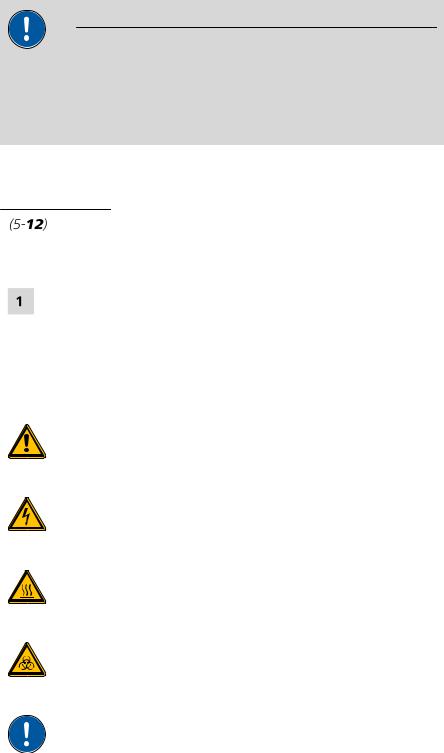
|
1 Introduction |
1.2About the documentation
CAUTION
Please read through this documentation carefully before putting the instrument into operation. The documentation contains information and warnings which the user must follow in order to ensure safe operation of the instrument.
1.2.1Symbols and conventions
The following symbols and formatting may appear in this documentation:
|
Cross-reference to figure legend |
|
The first number refers to the figure number, the sec- |
|
ond to the instrument part in the figure. |
|
|
|
Instruction step |
|
Carry out these steps in the sequence shown. |
|
|
Method |
Dialog text, parameter in the software |
|
|
File New |
Menu or menu item |
|
|
[Next] |
Button or key |
|
|
|
WARNING |
|
This symbol draws attention to a possible life-threat- |
|
ening hazard or risk of injury. |
|
|
|
WARNING |
|
This symbol draws attention to a possible hazard due |
|
to electrical current. |
|
|
|
WARNING |
|
This symbol draws attention to a possible hazard due |
|
to heat or hot instrument parts. |
|
|
|
WARNING |
|
This symbol draws attention to a possible biological |
|
hazard. |
|
|
|
CAUTION |
|
This symbol draws attention to possible damage to |
|
instruments or instrument parts. |
|
|
915 KF Ti-Touch |
3 |

1.2 About the documentation |
|
NOTE
This symbol highlights additional information and tips.
4 |
915 KF Ti-Touch |
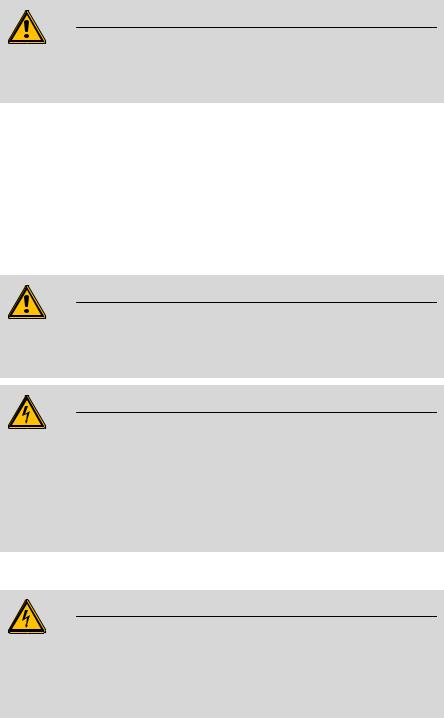
|
2 Safety instructions |
2 Safety instructions
2.1General notes on safety
WARNING
This instrument may only be operated in accordance with the specifications in this documentation.
This instrument has left the factory in a flawless state in terms of technical safety. To maintain this state and ensure non-hazardous operation of the instrument, the following instructions must be observed carefully.
2.2Electrical safety
The electrical safety when working with the instrument is ensured as part of the international standard IEC 61010.
WARNING
Only personnel qualified by Metrohm are authorized to carry out service work on electronic components.
WARNING
Never open the housing of the instrument. The instrument could be damaged by this. There is also a risk of serious injury if live components are touched.
There are no parts inside the housing which can be serviced or replaced by the user.
Mains voltage
WARNING
An incorrect mains voltage can damage the instrument.
Only operate this instrument with a mains voltage specified for it (see rear panel of the instrument).
915 KF Ti-Touch |
5 |
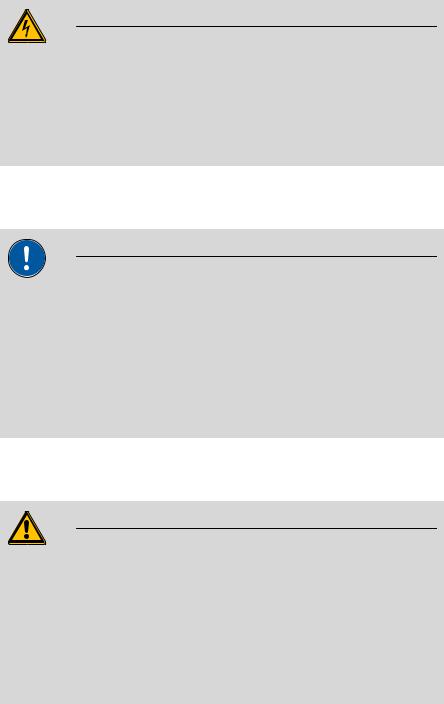
2.3 Tubing and capillary connections |
|
Protection against electrostatic charges
WARNING
Electronic components are sensitive to electrostatic charges and can be destroyed by discharges.
Do not fail to pull the mains cable out of the mains connection socket before you set up or disconnect electrical plug connections at the rear of the instrument.
2.3Tubing and capillary connections
CAUTION
Leaks in tubing and capillary connections are a safety risk. Tighten all connections well by hand. Avoid applying excessive force to tubing connections. Damaged tubing ends lead to leakage. Appropriate tools can be used to loosen connections.
Check the connections regularly for leakage. If the instrument is used mainly in unattended operation, then weekly inspections are mandatory.
2.4Flammable solvents and chemicals
WARNING
All relevant safety measures are to be observed when working with flammable solvents and chemicals.
Set up the instrument in a well-ventilated location (e.g. fume cupboard).
Keep all sources of flame far from the workplace.
Clean up spilled liquids and solids immediately.
Follow the safety instructions of the chemical manufacturer.
6 |
915 KF Ti-Touch |

|
2 Safety instructions |
2.5Recycling and disposal
This product is covered by European Directive 2002/96/EC, WEEE – Waste from Electrical and Electronic Equipment.
The correct disposal of your old equipment will help to prevent negative effects on the environment and public health.
More details about the disposal of your old equipment can be obtained from your local authorities, from waste disposal companies or from your local dealer.
915 KF Ti-Touch |
7 |
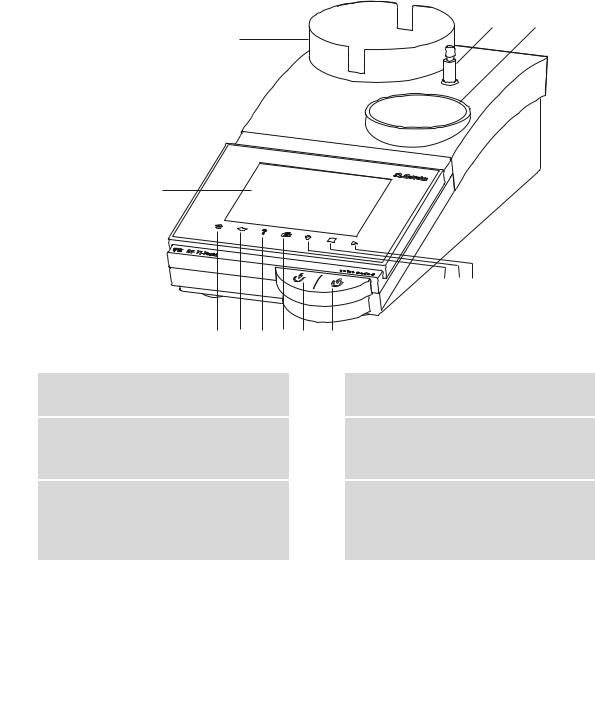
3.1 Front of the instrument |
|
3 Overview of the instrument
3.1Front of the instrument
12 13
11
1
8 9 10
2 3 4 5 6 7
Figure 1 Front 915 KF Ti-Touch
1Display
Touch-sensitive screen.
3Fixed key [Back]
Saves the entry and opens the next-higher dialog page.
5Fixed key [Print]
Opens the print dialog.
2Fixed key [Home]
Opens the main dialog.
4Fixed key [Help]
Opens the online help for the dialog displayed.
6Key
Pressing the key pumps air into the solvent bottle. The overpressure in the solvent bottle pushes solvent into the KF titration cell.
7 |
Key |
|
8 |
Fixed key [Manual] |
|
Pressing the key aspirates air out of the aspi- |
|
|
Opens the manual control. |
|
ration bottle. The vacuum in the aspiration |
|
|
|
|
bottle suctions the liquid out of the KF titra- |
|
|
|
|
tion cell and into the aspiration bottle. |
|
|
|
|
|
|
|
|
|
|
|
|
|
9 |
Fixed key [STOP] |
|
10 |
Fixed key [START] |
|
Cancels the running determination. |
|
|
Starts a determination. |
|
|
|
|
|
8 |
915 KF Ti-Touch |
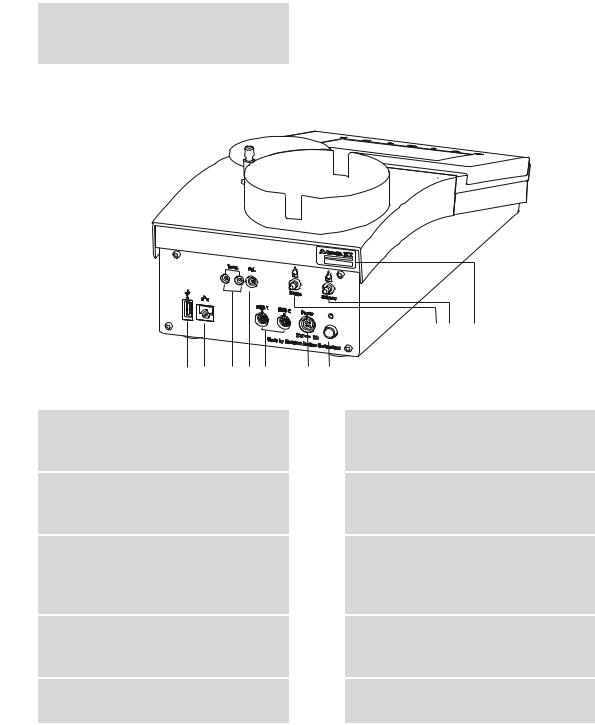
|
|
3 Overview of the instrument |
|
|
|
11 Bottle holder |
|
12 Support rod (lower part) |
With holding clips, for reagent bottle. |
|
For mounting the support rod (upper part). |
|
|
|
13Titration stand
With built-in magnetic stirrer and membrane pump for placement of the titration cell.
3.2Rear of the instrument
8 9 10
1 |
2 |
3 |
4 |
5 |
6 |
7 |
Figure 2 Rear 915 KF Ti-Touch
1USB connector (type A)
For connecting a printer, USB flash drive, USB hub, USB Sample Processor etc.
3Temperature sensor connector (Temp.)
For connecting temperature sensors (Pt1000 or NTC). Two B sockets, 2 mm.
5MSB connector (MSB 1 and MSB 2)
Metrohm Serial Bus. For connecting external dosing devices, stirrers or a Remote Box. Mini DIN, 8-pin.
7Mains switch
Switch the instrument on/off.
9Connection nipple for PVC tubing
For aspirating solvent.
2Ethernet connector (RJ-45)
For connecting to a network.
4Electrode connector (Pol.)
For connecting polarizable electrodes, e.g. double Pt electrodes. Socket F.
6Mains connection socket (Power)
For connecting the external power supply unit.
8Connection nipple for PVC tubing
For aspiration of the contents of the titration cell.
10Type plate
Contains the serial number.
915 KF Ti-Touch |
9 |

4.1 Setting up the instrument |
|
4 Installation
4.1Setting up the instrument
4.1.1Packaging
The instrument is supplied in highly protective special packaging together with the separately packed accessories. Keep this packaging, as only this ensures safe transportation of the instrument.
4.1.2Checks
Immediately after receipt, check whether the shipment has arrived complete and without damage by comparing it with the delivery note.
4.1.3Location
The instrument has been developed for operation indoors and may not be used in explosive environments.
Place the instrument in a location of the laboratory which is suitable for operation, free of vibrations, protected from corrosive atmosphere, and contamination by chemicals.
The instrument should be protected against excessive temperature fluctuations and direct sunlight.
4.2Connecting the power supply unit
The 915 KF Ti-Touch has an external power supply unit for a 24 V power supply (DC). This is connected to the mains connection of the Ti-Touch.
WARNING
An incorrect mains voltage can damage the device.
Operate the device only with the mains voltage specified for it. Use the supplied power supply unit exclusively.
10 |
915 KF Ti-Touch |
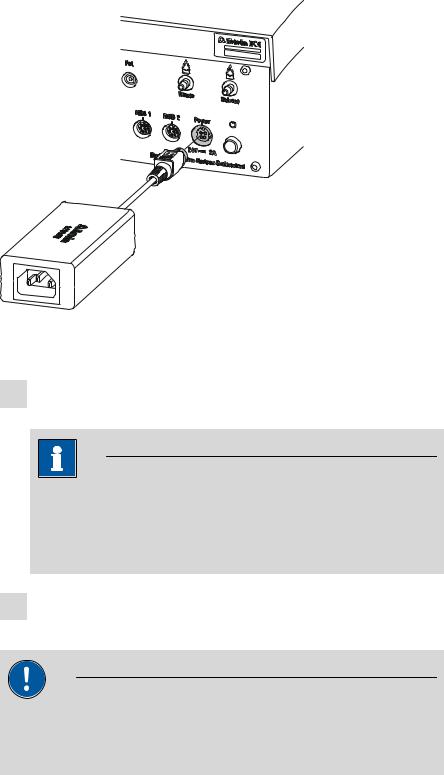
|
4 Installation |
Figure 3 Connecting the power supply unit
Proceed as follows:
1Connect the plug of the external power supply unit with the mains connection of the Ti-Touch (see Figure 3, page 11).
NOTE
The plug of the power supply unit is protected against accidental disconnection of the cable by means of a pull-out protection feature. If you wish to pull out the plug, you will first need to pull back the outer plug sleeve marked with arrows.
2Connect the mains cable with the external power supply unit of the Ti-Touch and with the mains supply.
CAUTION
Switch off the Ti-Touch correctly by pressing the mains switch before you disconnect the electricity supply. If this is not done, then there is a danger of data loss.
915 KF Ti-Touch |
11 |
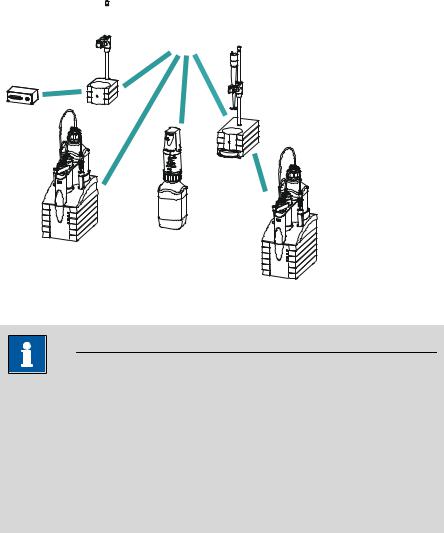
4.3 Connecting MSB devices |
|
4.3Connecting MSB devices
In order to connect MSB devices, e.g. dosing device or Remote-Box, the Ti-Touch has two connectors at what is referred to as the Metrohm Serial Bus (MSB). Various peripheral devices can be connected in sequence (Daisy Chain) at a single MSB connector (8-pin Mini DIN socket) and be controlled simultaneously by the Ti-Touch. In addition to the connection cable, stirrers and the Remote Box are each equipped with their own MSB socket for this purpose.
The following figure provides an overview of the devices that can be connected to an MSB socket, along with a number of different cabling variations.
Stirrer / Ti Stand 

MSB
Remote Box
Ti Stand / Stirrer
Dosino
Dosimat
Dosimat / Dosino
Figure 4 MSB connections
NOTE
When connecting MSB devices together, the following must be observed:
Only one device of the same type can be used at a single MSB connector at one time.
When making the connection, take care to ensure that the flat part of the MSB plug marked with arrows is pointing in the direction of the marking on the MSB connector (see Figure 5, page 13).
12 |
915 KF Ti-Touch |
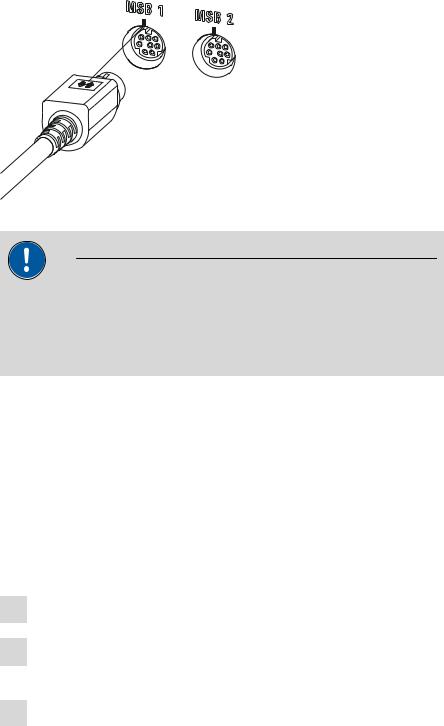
|
4 Installation |
Figure 5 MSB connector
CAUTION
Switch off the Ti-Touch before you plug in MSB devices. When it is switched on, the Ti-Touch automatically recognizes which device is connected to which MSB connector. The connected MSB devices are entered automatically in the device manager.
MSB connections can be extended with the 6.2151.010 cable. The maximum connection length permitted is 6 m.
4.3.1Connecting dosing devices
You can connect two dosing devices to the Ti-Touch.
The types of dosing devices that are supported are:
800 Dosino
805 Dosimat
Proceed as follows:
1 Switch off the Ti-Touch.
2Connect the dosing device connection cable to an MSB connector (2-5) on the rear side of the Ti-Touch.
3 Switch on the Ti-Touch.
915 KF Ti-Touch |
13 |

4.3 Connecting MSB devices |
|
4.3.2Connecting an additional stirrer or titration stand
In addition to the built-in magnetic stirrer, you can also use the magnetic stirrers 801 Stirrer, 803 Ti Stand or the 804 Ti Stand with the propeller stirrer 802 Stirrer.
Proceed as follows:
1 Switch off the Ti-Touch.
2Connect the connection cable of the magnetic stirrer or of the titration stand to MSB 2 (2-5) on the rear of the Ti-Touch.
3Connect the propeller stirrer, if desired, to the stirrer connector of the titration stand.
4Switch on the Ti-Touch.
4.3.3Connecting a Remote Box
Instruments that are controlled via remote lines and/or which send control signals via remote lines can be connected using the 6.2148.010 Remote Box. In addition to Metrohm, other instrument manufacturers also use similar connectors that make it possible to connect different instruments together. These interfaces are also frequently given the designations "TTL Logic", "I/O Control" or "Relay Control" and generally have a signal level of 5 volts.
Control signals are understood to be electrical line statuses or brief (> 200 ms) electrical pulses which display the operational state of an
instrument or which trigger or report an event. Sequences on a variety of instruments can thus be coordinated in a single complex automation system. No exchange of data is possible, however.
Proceed as follows:
1 Switch off the Ti-Touch.
2Connect the Remote Box connection cable to an MSB connector (2-5) on the rear side of the Ti-Touch.
3 Switch on the Ti-Touch.
You can connect an 885 Compact Oven SC. The Remote Box also has an MSB socket at which a further MSB device, e.g. a dosing device, can be connected.
14 |
915 KF Ti-Touch |

|
4 Installation |
You will find precise information concerning the pin assignment of the interface on the Remote Box in Appendix (see Chapter 31.5, page 341).
4.4Connecting USB devices
4.4.1General
The 915 KF Ti-Touch has a USB connector (Type A socket) for peripheral devices with USB interface and for USB Sample Processors. If you wish to connect more than one device to the USB, you can also use an additional commercially available USB hub.
NOTE
We recommend that the Ti-Touch be switched off while you set up or disconnect connections between the devices.
4.4.2Connecting a USB hub
Use a USB hub with its own power supply.
Connect the USB hub as follows:
1With the help of the 6.2151.030 cable (length 0.6 m) or the 6.2151.020 cable (length 1.8 m), connect the USB connector of the Ti-Touch (Type A) with the USB connector of the hub (Type B, see manual for the USB hub).
The USB hub is recognized automatically.
4.4.3Connecting a printer
Printers that are connected to the 915 KF Ti-Touch must meet the following requirements:
Printer languages: HP-PCL, HP-PCL-GUI, Canon BJL Commands or Epson ESC P/2
Paper format: A4 or Letter, single-sheet feed.
Connect the printer as follows:
1With the aid of the 6.2151.020 cable, connect the USB connector of the Ti-Touch (type A) with the USB connector of the printer (type B, see manual for the printer).
2Configure the printer in the device manager of the Ti-Touch (see Chapter 11.7, page 101).
915 KF Ti-Touch |
15 |
4.4 Connecting USB devices |
|
4.4.4Connecting a balance
If you wish to connect a balance to the Ti-Touch, you will require a USB/
RS-232 adapter (6.2148.050).
The following table offers an overview of the balances that you can use together with the Ti-Touch and of which cable you will need for connection to the RS-232 interface:
Balance |
Cable |
|
|
|
|
AND ER, FR, FX with RS-232 inter- |
6.2125.020 + 6.2125.010 |
|
face (OP-03) |
|
|
|
|
|
Mettler AB, AG, PR (LC-RS9) |
In the scope of delivery for the |
|
|
balance |
|
|
|
|
Mettler AM, PM, PE with interface |
6.2146.020 + 6.2125.010 |
|
option 016 |
also from Mettler: ME 47473 |
|
|
||
or |
adapter and either ME 42500 |
|
Mettler AJ, PJ with interface |
hand switch or ME 46278 foot |
|
switch |
||
option 018 |
||
|
||
|
|
|
Mettler AT |
6.2146.020 + 6.2125.010 |
|
|
also from Mettler: ME 42500 |
|
|
hand switch or ME 46278 foot |
|
|
switch |
|
|
|
|
Mettler AX, MX, UMX, PG, AB-S, |
6.2134.120 |
|
PB-S, XP, XS |
|
|
|
|
|
Mettler AE with interface option |
6.2125.020 + 6.2125.010 |
|
011 or 012 |
also from Mettler: ME 42500 |
|
|
||
|
hand switch or ME 46278 foot |
|
|
switch |
|
|
|
|
Ohaus Voyager, Explorer, Analyti- |
Cable AS017-09 from Ohaus |
|
cal Plus |
|
|
|
|
|
Precisa balances with RS-232-C |
6.2125.080 + 6.2125.010 |
|
interface |
|
|
|
|
|
Sartorius MP8, MC, LA, Genius, |
6.2134.060 |
|
Cubis |
|
|
|
|
|
Shimadzu BX, BW |
6.2125.080 + 6.2125.010 |
|
|
|
16 |
915 KF Ti-Touch |
